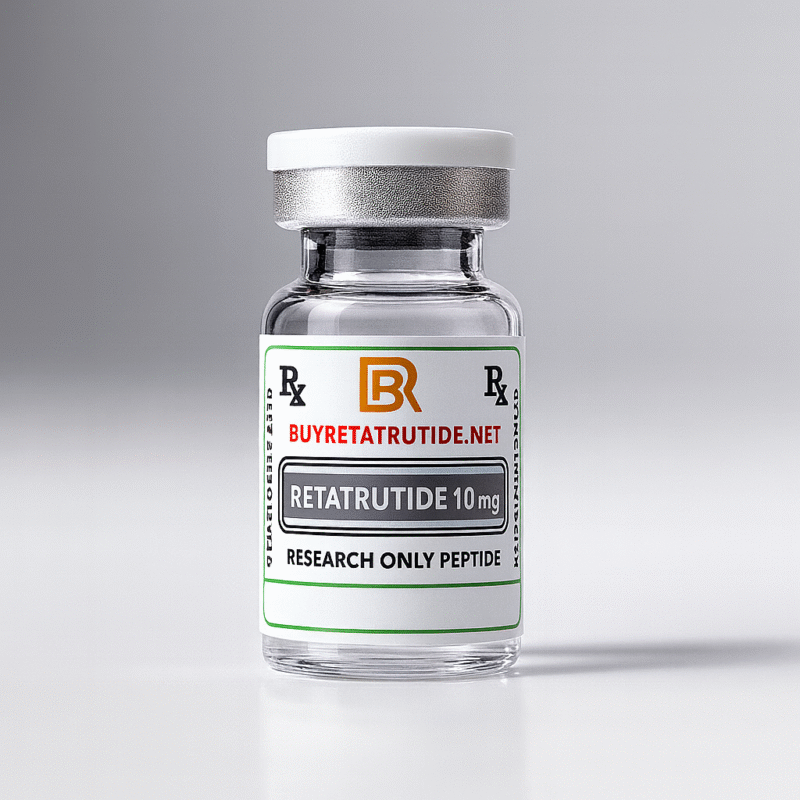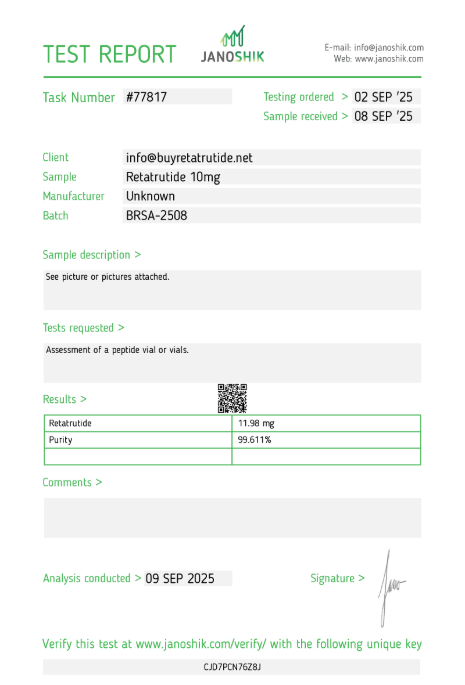Preparation Steps
Proper preparation and injection techniques are essential for safe and effective Retatrutide administration. Begin by washing your hands thoroughly with soap and water for at least 20 seconds to ensure cleanliness and prevent contamination.
Gather all necessary supplies before starting the injection process. You will need the Retatrutide vial, a sterile syringe with appropriate needle size, alcohol swabs, and a sharps disposal container. Ensure all supplies are within their expiration dates and have been stored according to manufacturer guidelines.
Allow the Retatrutide vial to reach room temperature if it has been refrigerated. Cold medication can cause discomfort during injection and may affect absorption. Remove the vial from refrigeration approximately 30 minutes before administration.
Inspect the Retatrutide solution for any signs of contamination or damage. The solution should be clear and colourless. Do not use if the solution appears cloudy, contains particles, or has changed colour. Check the vial for cracks or damage before proceeding.
Choose an appropriate injection site and clean the area thoroughly with an alcohol swab. Allow the alcohol to dry completely before proceeding with the injection to ensure proper sterilisation and prevent stinging during administration.
Ready to Order?
Choose your preferred amount below, fast shipping and secure checkout.
-
Reta 10mg 3 Vials
£195.00Independently verified COA. UK stock, worldwide delivery. For lab use only.
Injection Sites
Retatrutide can be administered subcutaneously in several approved injection sites. The most common sites include the abdomen, thigh, and upper arm. Each site offers specific advantages and considerations for optimal administration.
The abdomen is often preferred for Retatrutide injections due to consistent absorption and ease of access. Inject at least 2 inches away from the navel and rotate injection sites to prevent lipodystrophy. Avoid areas with scars, moles, or skin irritation.
The thigh provides an alternative injection site with good absorption characteristics. Use the front and outer areas of the thigh, avoiding areas near joints or blood vessels. This site is particularly suitable for patients who prefer not to inject in the abdomen.
The upper arm can be used for Retatrutide administration, though it may require assistance for self-injection. Choose the back of the upper arm, avoiding areas near the shoulder joint. This site may be more challenging for patients with limited mobility.
Rotate injection sites systematically to prevent tissue damage and ensure consistent absorption. Keep a record of injection sites and dates to maintain proper rotation. Avoid injecting into areas that are bruised, swollen, or tender from previous injections.
Injection Method
Subcutaneous injection techniques are crucial for effective Retatrutide delivery. Begin by drawing the prescribed dose into a sterile syringe, ensuring accurate measurement according to your healthcare provider’s instructions.
Hold the syringe like a pencil and insert the needle at a 45-degree angle for subcutaneous injection. The needle should penetrate the skin and enter the subcutaneous tissue layer beneath the dermis. Avoid injecting too shallowly or too deeply.
Inject the Retatrutide solution slowly and steadily to minimise discomfort and ensure proper distribution. Rapid injection can cause pain and may affect absorption. Take approximately 5-10 seconds to complete the injection.
After injecting the full dose, hold the syringe in place for a few seconds before withdrawing the needle. This helps prevent medication leakage and ensures complete delivery of the prescribed dose.
Withdraw the needle smoothly and apply gentle pressure to the injection site with a clean cotton ball or gauze pad. Do not rub the area, as this can cause irritation or bruising. Dispose of the used syringe immediately in a sharps container.
Safety Considerations
Safety is paramount when administering Retatrutide injections. Always use sterile technique to prevent infection and contamination. Never reuse syringes or needles, even for the same patient, as this can lead to serious complications.
Verify the correct medication and dose before each injection. Check the vial label to ensure you have the right medication and confirm the prescribed dose with your healthcare provider’s instructions. Double-check calculations for dose adjustments.
Monitor injection sites for signs of infection, including redness, swelling, warmth, or drainage. Contact your healthcare provider immediately if you notice any concerning symptoms or if injection sites become painful or inflamed.
Be aware of potential allergic reactions to Retatrutide or injection components. Symptoms may include rash, itching, swelling, or difficulty breathing. Seek immediate medical attention if you experience signs of an allergic reaction.
Store Retatrutide and injection supplies according to manufacturer guidelines to maintain potency and sterility. Protect medications from light, heat, and contamination. Check expiration dates regularly and dispose of expired products properly.
Troubleshooting
Common injection issues can often be resolved with proper technique and preparation. If you experience pain during injection, ensure the medication is at room temperature and that you are using the correct injection angle and depth.
Bruising at injection sites may occur occasionally and is usually harmless. To minimise bruising, avoid injecting into areas with visible blood vessels, use appropriate needle size, and apply gentle pressure after injection without rubbing.
If medication leaks from the injection site, you may not have injected deeply enough or may have withdrawn the needle too quickly. Ensure proper injection techniques and hold the syringe in place for a few seconds after injection.
Difficulty drawing medication into the syringe may indicate a problem with the vial or syringe. Check that the vial is not damaged and that the syringe is functioning properly. Contact your pharmacist if you encounter persistent problems.
If you miss a scheduled injection, contact your healthcare provider for guidance on when to take the next dose. Do not double up on doses without medical supervision, as this can increase the risk of side effects. For comprehensive guidance on managing missed doses, consult our missed dose protocols guide.
Storage and Handling
Proper storage of Retatrutide is essential for maintaining medication potency and safety. Store unopened vials in the refrigerator between 2°C and 8°C until the expiration date. Do not freeze Retatrutide, as this can damage the medication. For detailed storage guidelines, including temperature control and handling protocols, refer to our comprehensive storage guide.
Once opened, Retatrutide vials can be stored at room temperature for up to 28 days. Keep opened vials away from direct sunlight and heat sources. Mark the opening date on the vial to track storage time.
Protect Retatrutide from light exposure by storing in the original packaging or a light-resistant container. Exposure to light can degrade the medication and reduce its effectiveness.
Handle Retatrutide vials carefully to prevent breakage and contamination. Do not shake the vial vigorously, as this can cause foaming and affect the medication. Gently roll the vial between your hands if mixing is needed.
Keep Retatrutide and injection supplies out of reach of children and pets. Store in a secure location that maintains appropriate temperature conditions and protects against accidental exposure. When travelling with Retatrutide, follow our travel storage guidelines to ensure proper temperature control and medication integrity during transit.
Disposal Guidelines
Proper disposal of used injection supplies is crucial for safety and environmental protection. Place used syringes, needles, and other sharp objects immediately into a FDA-approved sharps disposal container.
Never dispose of needles or syringes in household rubbish bins, recycling containers, or down the toilet. This poses serious risks to waste management workers and can cause environmental contamination.
Sharps disposal containers should be puncture-resistant and clearly labelled. Fill containers only to the indicated fill line to prevent accidental needle sticks when closing the container.
When the sharps container is full, seal it according to manufacturer instructions and dispose of it according to local regulations. Many pharmacies and healthcare facilities offer sharps disposal services.
Unused or expired Retatrutide should be returned to a pharmacy or healthcare facility for proper disposal. Do not flush medications down the toilet or pour them down drains, as this can contaminate water supplies.
Best Practices
Establishing consistent routines can improve injection success and patient comfort. Choose a regular time for injections and stick to the schedule as much as possible to maintain consistent medication levels.
Keep detailed records of injection dates, times, doses, and injection sites. This information helps track treatment progress and identify any patterns in side effects or injection site reactions.
Maintain a clean, organised injection area with all necessary supplies readily available. This reduces the risk of contamination and makes the injection process more efficient and less stressful.
Regular communication with your healthcare provider is essential for optimal treatment outcomes. Report any injection-related concerns, side effects, or difficulties with administration promptly.
Consider joining support groups or educational programmes for patients using injectable medications. These resources can provide valuable tips, encouragement, and practical advice for successful treatment management. If you need to discontinue Retatrutide treatment, consult our discontinuation effects guide to understand potential withdrawal symptoms and management strategies.
Order Retatrutide Online
Available in 10mg vials. Select your pack size and checkout securely below.
-
Reta 10mg 3 Vials
£195.00Independently verified COA. UK stock, worldwide delivery. For lab use only.
Frequently Asked Questions
- What is the best injection site for Retatrutide? The abdomen is generally preferred due to consistent absorption and ease of access, but the thigh and upper arm are also suitable alternatives. Rotate sites to prevent tissue damage.
- How often should I rotate injection sites? Rotate injection sites with each dose to prevent lipodystrophy and tissue damage. Keep a record of injection sites and dates to ensure proper rotation.
- What should I do if I miss an injection? Contact your healthcare provider for guidance on when to take the next dose. Do not double up on doses without medical supervision.
- Can I reuse syringes or needles? Never reuse syringes or needles, even for the same patient. Always use sterile, single-use injection supplies to prevent infection and contamination.
- How should I store Retatrutide? Store unopened vials in the refrigerator between 2°C and 8°C. Once opened, vials can be stored at room temperature for up to 28 days.
- What should I do if I experience injection site reactions? Monitor injection sites for signs of infection or allergic reaction. Contact your healthcare provider if you notice redness, swelling, warmth, or drainage.
- How do I dispose of used injection supplies? Place used syringes and needles immediately into a FDA-approved sharps disposal container. Never dispose of sharps in household rubbish bins.
- What angle should I use for subcutaneous injection? Insert the needle at a 45-degree angle for subcutaneous injection. Ensure the needle penetrates the skin and enters the subcutaneous tissue layer.

